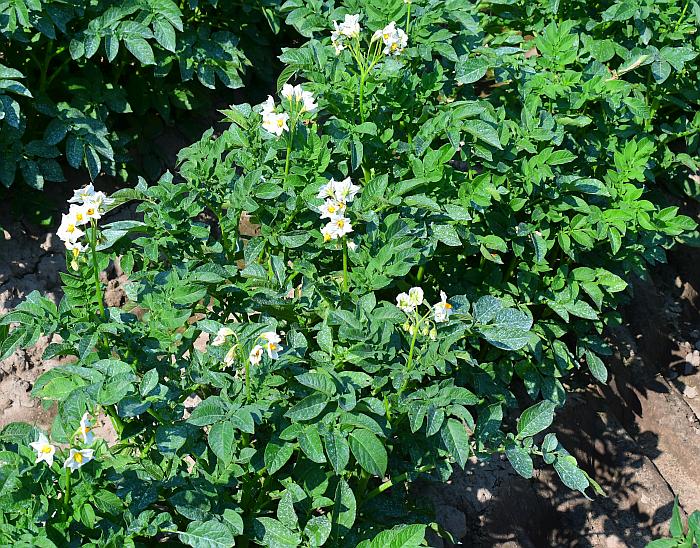Solanum tuberosum L.
Potato

Introduced
CC = *
CW = 5
MOC = 2
© SRTurner
Solanum tuberosum L.Potato | |
 |
Introduced CC = * CW = 5 MOC = 2 |
© SRTurner |
|
Family - Solanaceae Habit - Plants perennial, usually blooming the first year, fibrous-rooted, with slender, fleshy offsets bearing narrowly oblong to ovoid, oblong-ellipsoid, or depressed-globose tubers. Stems - Lax to ascending or erect, 15-70 cm long, sometimes angled or with narrow, wavy wings of green tissue decurrent from the leaf bases, sparsely to moderately pubescent with short, spreading, multicellular, nonglandular hairs, sometimes also sticky; unarmed.
Leaves - Alternate, petiolate, often compound. Blades 7-18 cm long, those of the larger leaves irregularly pinnately compound (the smaller leaves merely deeply pinnatifid, the leaflets unequal, the main leaflets 5-9, 1-8 cm long, the terminal leaflet usually larger than the lateral ones, narrowly attached and mostly short-stalked, interspersed along the rachis with much smaller leaflets, ovate to broadly ovate, oblong-ovate, or elliptic, rounded or more commonly tapered to a bluntly or sharply pointed tip, tapered to rounded at the sometimes somewhat oblique base, the margins entire, the surfaces sparsely to moderately pubescent with short, nonglandular hairs, especially along the main veins on the undersurface.
Inflorescences - Panicles, terminal or appearing lateral from the uppermost nodes, with 7-25 well-spaced flowers, the flower stalks pubescent and inconspicuously jointed at or above the midpoint. Flowers ascending to spreading.
Flowers - Calyces 4-9 mm long, deeply 5-lobed, spreading to slightly reflexed at fruiting, the lobes variously ovate-triangular to linear above a short, ovate-triangular base, the outer surface nonglandular-hairy, sometimes also with scattered, sessile to short-stalked glands. Corollas 12-28 mm long, white to purple, shallowly lobed to above the midpoint, the lobes broadly ovate to broadly triangular, spreading at full flowering, the margins usually somewhat corrugated or slightly ruffled, the inner surface glabrous, the outer surface minutely hairy toward the tip. Anthers 5-7 mm long, narrowly oblong, lacking a sterile tip, dehiscent by terminal pores. Ovary 2-locular, the surface glabrous, the style exserted from the anther ring.
Fruits - Berries 1.0-2.5 cm long, globose, lacking granules, the surface glabrous, green mottled with dark green, becoming yellow or more commonly strongly purplish-mottled with age, somewhat shiny, sometimes with widely scattered, small, white flecks. Seeds 1.8-2.2 mm long, ovate to broadly oblong-ovate in outline, flattened, not winged, the surface appearing fuzzy (covered with an outer layer of disrupted cell walls that render the surface mucilaginous when wetted), whitish green to light brown. Flowering - June - August. Habitat - Railroads, open disturbed areas. Widely cultivated as a food crop. Origin - Native to South America. Lookalikes - Broadly, other members of the Solanum and Lycopersicum genera. Other info. - This is the common potato, an extremely important commercial food crop with dozens of varieties known. Domestication for human use first occurred in South America, over 7,000 years ago. Though extensively cultivated, the plant is virtually unknown in the wilds of Missouri. Extensive breeding and cultivar development has mostly focused on manipulating the character of the fleshy tubers, which vary in size, shape, color, texture, and starch content. Potato starch refined from the tubers is also used for numerous purposes, being produced annually in amounts exceeding 3 million tons. From the farmer's standpoint, the flowers and fruits are without value, and the fruits are indeed poisonous due to their content of the alkaloid solanine. Photographs taken near Fremont, Newaygo County, MI, 7-4-2021 and 7-5-2022 (SRTurner). |